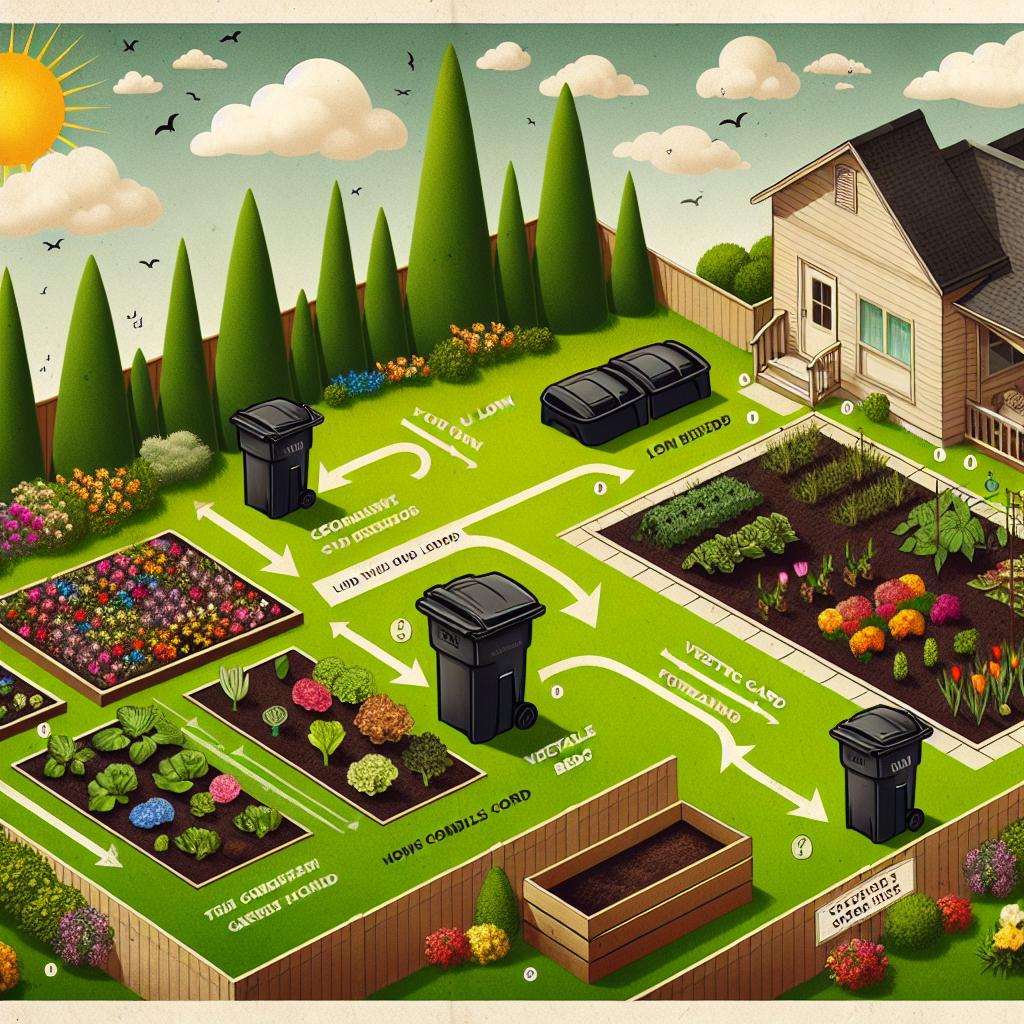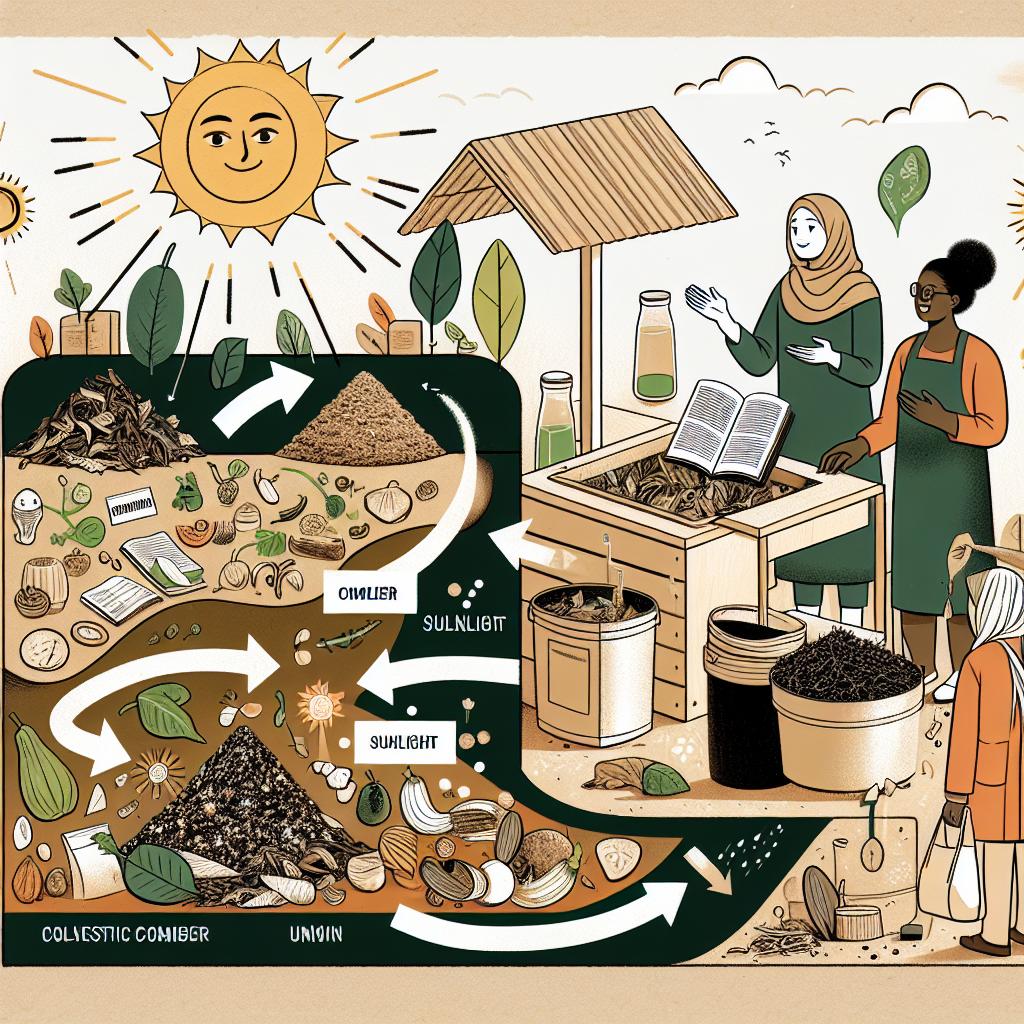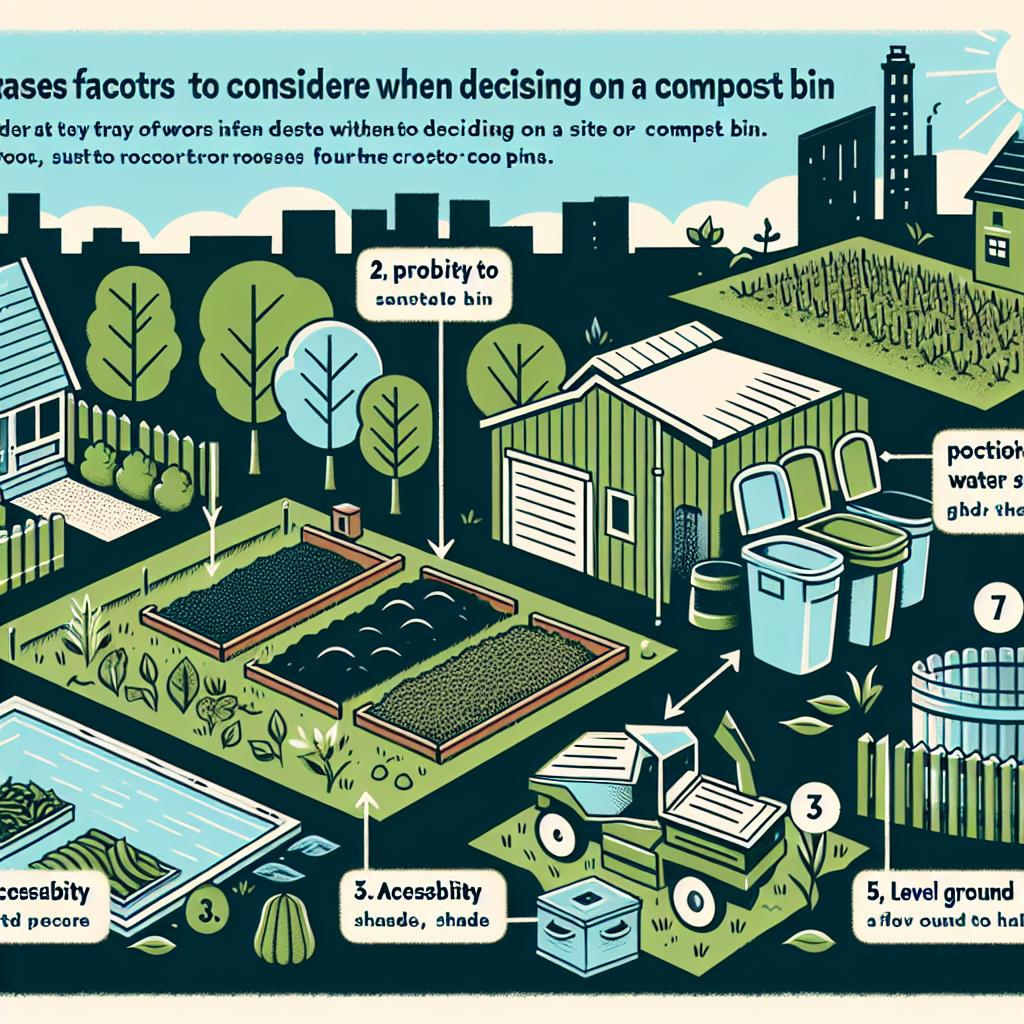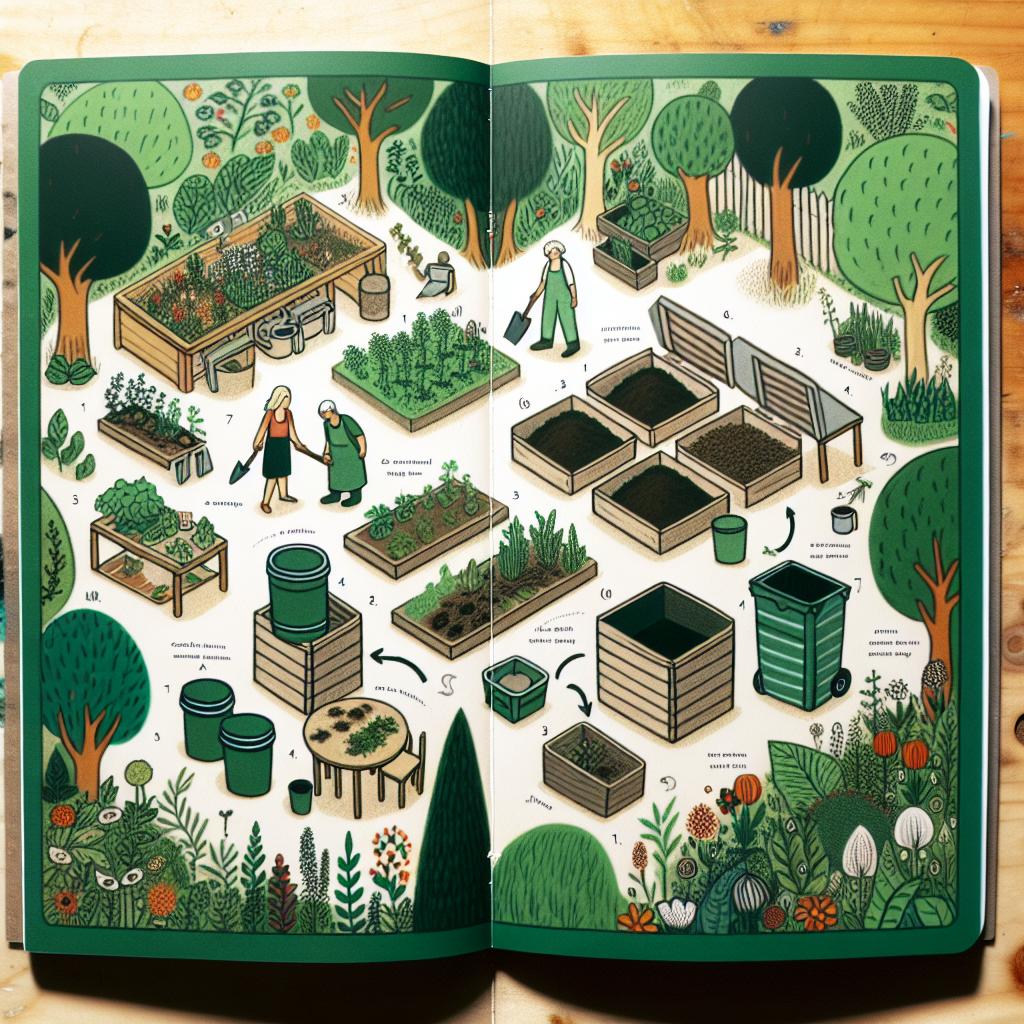Unearthing the best location for your compost bin can be a whimsical tango between nature and practicality. Like a dance partner, the perfect spot needs to align with the rhythm of Mother Earth while accommodating your daily routine. But fear not, fellow compost enthusiasts, as we embark on an exploration of the nether regions of your garden, together we shall unveil the secrets of the sacred ground for your compost bin. Prepare to sashay around the nooks and crannies of your outdoor space, as we navigate the delicate steps required to find the harmonious home where your compost dreams will come to life. It’s time to don your gardening shoes and take the plunge into this ballet of organic waste, where the stage is set, and the audience, all of Mother Nature’s creatures, awaits. Let the compost bin prowl commence!

Choosing the Perfect Location for Your Compost Bin
Finding the perfect location for your compost bin is crucial for its success and efficiency. Here are some key considerations to help you decide where to place your compost bin:
- Accessibility: Choose a location that is easily accessible to make it convenient for regular use and maintenance. You don’t want to trek across your yard every time you have kitchen scraps to add to the bin.
- Sunlight Exposure: While composting can occur in shady areas, a little bit of sunlight goes a long way in speeding up the decomposition process. Aim for a location that receives at least a few hours of sunlight each day to keep your compost cooking.
- Drainage: Ensure that the area you choose has good drainage to prevent your compost from getting waterlogged. Standing water can lead to unpleasant odors and slow down the composting process.
- Odor Control: Speaking of odors, consider placing your compost bin away from seating areas and pathways. While a well-maintained compost bin shouldn’t produce foul smells, it’s always wise to keep it at a distance, just in case.
To summarize, an ideal location for your compost bin would be easily accessible, receive some sunlight, have good drainage, and be situated away from frequently used areas. Following these guidelines will help you create a productive and odor-free composting system for all your organic waste.
| Consideration | Ideal | Not Ideal |
|---|---|---|
| Accessibility | Close to the kitchen or garden | Far from main activity areas |
| Sunlight Exposure | A few hours of sunlight each day | Full shade |
| Drainage | Well-drained area | Low-lying, waterlogged spot |
| Odor Control | Away from seating areas | Next to outdoor living spaces |

Understanding the Importance of Sunlight in Composting
When it comes to composting, sunlight plays a crucial role in accelerating the decomposition process and ensuring optimal nutrient breakdown. The right placement of your compost bin allows for the perfect amount of sunlight to reach your organic waste and kickstart the microbial activity.
Here are a few key factors to consider when deciding where to put your compost bin:
- Sun exposure: Find a spot in your yard that receives at least 6-8 hours of sunlight each day. Sunlight helps heat up the compost, promoting faster decomposition and killing off harmful pathogens.
- Convenience: Choose a location that is easily accessible for adding kitchen scraps, garden waste, and turning the compost. This can be near your kitchen or garden for effortless composting.
- Drainage: Ensure that the area has proper drainage to prevent waterlogging, which can lead to a stinky and anaerobic compost pile. Avoid low-lying areas or places where rainwater tends to collect.
Additionally, keep in mind that extreme temperatures can impact the composting process. If you live in a region with scorching summers, it might be beneficial to place your compost bin in a partially shaded area to prevent excessive drying out. Alternatively, colder climates may warrant a sunnier location to help maintain warmth.
| Materials to Compost | Materials to Avoid |
|---|---|
| Fruit and vegetable scraps | Diseased plants |
| Coffee grounds and filters | Meat and dairy products |
| Leaves and grass clippings | Greasy or oily foods |
Remember, proper placement of your compost bin is essential for successful composting. With ample sunlight, convenient access, and good drainage, you’ll be on your way to producing nutrient-rich compost for your garden!

The Role of Air Circulation in Compost Bin Placement
When it comes to compost bin placement, many factors need to be considered. One crucial aspect to keep in mind is the role of air circulation. Proper air circulation is essential for an efficient composting process, as it helps to maintain the right balance of oxygen levels and prevent unpleasant odors.
To ensure optimal air circulation within your compost bin, here are some key points to consider:
- Choose a Well-Ventilated Area: Look for a spot in your garden that receives good air flow throughout the day. Avoid placing the bin in a completely enclosed space, as this can hinder airflow.
- Avoid Direct Sunlight: While some sunlight is beneficial, excessive heat can dry out the compost and slow down decomposition. Find a location that offers a balance of shade and sunlight.
- Keep a Safe Distance: Ensure your compost bin is placed at least one or two feet away from any structures, such as fences or buildings. This allows air to freely circulate and prevents potential damage.
- Consider Wind Direction: If you live in an area with strong prevailing winds, it’s wise to position your compost bin in a way that utilizes the natural airflow. This can be achieved by facing the bin against the direction of the prevailing winds.
In summary, air circulation plays an important role in the placement of a compost bin. By choosing a well-ventilated area, avoiding direct sunlight, keeping a safe distance from structures, and considering wind direction, you can create an ideal environment for effective composting.

Finding the Right Balance of Moisture for Your Compost Bin
Maintaining the ideal moisture level in your compost bin is crucial in order to support the decomposition process and ensure your compost is healthy and productive. Too much moisture can lead to a smelly, anaerobic mess, while too little moisture can slow down decomposition. So, how do you find the right balance of moisture for your compost bin?
Firstly, it’s important to know that moisture levels can vary depending on the type of composting method you’re using. For traditional compost bins, which are typically open-air, the moisture level should be around 40-60%. This can be achieved by adding water to the compost pile as needed, especially during dry weather or if the materials are particularly dry. On the other hand, if you’re using a closed or indoor composting system like a worm bin, the moisture level should be closer to 80%. This can be achieved by regularly misting the compost, making sure not to saturate it.
To determine the moisture level of your compost, you can use a simple test. Take a handful of compost and squeeze it in your hand. If it sticks together and feels damp, but no water drips out, then the moisture level is just right. If it feels dry and crumbles easily, it’s too dry and will need more water. On the other hand, if water drips out when you squeeze it, the compost is too wet and you’ll need to add some dry materials like straw or shredded paper to absorb the excess moisture.
Remember, is a bit of trial and error. It’s important to regularly check and adjust the moisture level to ensure optimal conditions for decomposition. By keeping a close eye on the moisture, you’ll be well on your way to producing rich, nutrient-dense compost for your garden.
The Advantages of Locating Your Compost Bin Near a Water Source
The location of your compost bin plays a crucial role in its overall functionality and convenience. One of the most advantageous places to position your compost bin is near a water source. Not only does this placement simplify the process of keeping your compost moist, but it also offers several other benefits that can significantly enhance the efficiency of your composting system.
First and foremost, having a water source nearby allows for easy access when it comes to watering your compost heap. Maintaining the right level of moisture is essential for optimal decomposition. By having a hose or watering can within close reach, you can efficiently and effectively moisten your compost as needed. This proximity eliminates the need for inconvenient trips back and forth from your bin to fetch water, saving you time and effort. Furthermore, when you have a water source nearby, it becomes more convenient to monitor the moisture content of your compost regularly, ensuring that it remains within the ideal range for decomposition.
Another advantage of having a water source near your compost bin is the opportunity to utilize water runoff for additional benefits. During watering, excess moisture from the bin can escape through drainage holes or the bottom of the compost container. This runoff can be captured and collected in a small rainwater tank or a container, providing you with a free and natural source of water for other gardening needs. Utilizing this recycled water not only promotes sustainability but also reduces your reliance on municipal water sources, ultimately contributing to a greener and more eco-friendly lifestyle.
are undeniable. From easy access to consistent moisture and the opportunity to tap into recycled water, this strategic placement maximizes the efficiency and convenience of your composting system. So, why settle for a distant spot when you can enjoy all the benefits of having your compost bin in close proximity to a water source
Exploring Factors to Consider When Deciding on a Compost Bin Site
When it comes to setting up a compost bin, choosing the right location is crucial for successful composting. The site you select can impact the decomposition process, the overall aesthetics of your garden, as well as the convenience of managing your compost. Here are some factors to consider when deciding on the perfect spot for your compost bin:
- Sunlight Exposure: Find a spot that receives a good amount of sunlight throughout the day. Sunlight is essential for speeding up the composting process and helps to keep the pile warm, promoting the growth of beneficial bacteria and fungi.
- Proximity to the Kitchen: Consider placing your compost bin near your kitchen for easy access. It’s convenient to have a designated spot where you can quickly dispose of kitchen scraps and organic waste, reducing the likelihood of odors or attracting unwanted pests.
- Drainage: Ensure the site has proper drainage to prevent compost from becoming waterlogged. Avoid areas with poor drainage, such as low-lying spots or areas prone to flooding.
If you have limited space, you can consider using compost tumblers or compact compost bins that require less area. Remember that having multiple smaller compost bins spread throughout your garden can be beneficial in distributing compost to various areas.
| Pros | Cons |
|---|---|
| Convenient access for kitchen waste disposal | Requires regular monitoring and maintenance |
| Promotes faster decomposition with proper sunlight | Potential odor issues if not managed correctly |
| Reduces waste sent to landfill and benefits the environment | May attract pests if not properly maintained |
Remember, finding the right location for your compost bin is an exciting opportunity to not only manage waste responsibly but also enhance the health and vitality of your garden. By considering these factors, you can create the ideal environment for your compost to thrive and transform into nutrient-rich soil.

Tips for Allocating Space in Small Gardens for Compost Bins
When it comes to small gardens, finding space for a compost bin can seem like a daunting task. However, with some strategic planning and a little creativity, you can easily allocate the perfect spot for your compost bin. Here are a few tips to help you maximize space:
1. Utilize vertical space:
Instead of thinking horizontally, consider going vertical. Hang your compost bin on a wall or fence using hooks or brackets. This way, you can save precious floor space while still having easy access to your compost.
2. Choose a compact design:
Opt for a compact compost bin that fits well in small spaces. Look for stackable or collapsible models that can be easily stored when not in use. There are even compost bins designed to fit in tight corners or under raised beds, making efficient use of every inch.
3. Find hidden nooks:
Explore your garden thoroughly and identify hidden nooks and crannies where a compost bin can be tucked away. Consider areas behind bushes, under staircases, or even beneath a garden bench. Any unused corner can become a composting haven.
4. Optimize existing structures:
If you have existing structures in your garden, such as a shed or a greenhouse, take advantage of their vertical surfaces. Attach a compost bin to the side of a shed or hang it from the roof of a greenhouse. Use the space you already have without making drastic changes to your garden layout.
5. Create a compact composting system:
Consider using a worm composting system, also known as vermicomposting. This method uses a container filled with worms to break down organic matter quickly and efficiently. Worm composting takes up minimal space and can be done both indoors and outdoors.

Considering the Impact of Surrounding Elements on Composting Efficiency
When it comes to deciding where to put your compost bin, it’s important to take into consideration the impact of surrounding elements on its efficiency. The location of your compost bin can greatly affect the decomposition process and overall nutrient production of your compost. Let’s explore some key factors to consider:
- Sunlight Exposure: Find a spot that receives a moderate amount of sunlight throughout the day. Too much sun exposure can dry out the pile, while too little can slow down the decomposition process.
- Proximity to Water Source: Ensure your compost bin is conveniently located close to a water source. This will make it easier to keep the compost moist, which is crucial for the breakdown of organic materials.
- Air Circulation: Adequate airflow is vital for composting. Avoid placing your bin in an area completely surrounded by walls or fences, as this can limit oxygen supply. Instead, opt for an open area that allows for natural ventilation.
- Drainage: It’s essential for excess water to be able to drain from your compost bin. Consider placing it on slightly elevated ground or using a raised bed with drainage holes to prevent waterlogged compost.
In addition to these aspects, it’s also important to consider any potential odors that may arise from your compost bin. Ideally, it should be placed away from living areas or areas where the smell might be bothersome. By carefully selecting the location for your compost bin, you can optimize its efficiency and ensure a well-balanced ecosystem where organic waste transforms into nutrient-rich compost for your garden.

The Dos and Don’ts of Compost Bin Placement in Urban Settings
Choosing the Right Spot
When it comes to compost bin placement in urban settings, there are certain dos and don’ts to consider. The first thing to remember is to choose a spot that receives a sufficient amount of sunlight. Ideally, your compost bin should be placed in an area that gets at least six hours of direct sunlight each day. Sunlight helps accelerate the decomposition process and ensures the breakdown of organic matter into nutrient-rich compost.
Another important factor to consider is the proximity to your living space. While it may be tempting to place the compost bin near your kitchen for convenience, it’s best to keep it at a reasonable distance to avoid any unwanted odors. You could position it in a discreet corner of your backyard or patio, as long as it’s easily accessible for you to add kitchen scraps and turn the pile when needed. Remember, composting is a natural process, but it’s essential to be mindful of your neighbors’ potential concerns.
The Do’s
- Do: Place your compost bin in a sunny spot to speed up decomposition.
- Do: Ensure easy accessibility for adding materials and turning the pile.
- Do: Consider using a compost bin with a lid to control moisture and prevent pests.
- Do: Use a compost bin that allows for proper aeration to promote decomposition.
- Do: Monitor the moisture levels in your compost and adjust as necessary.
The Don’ts
- Don’t: Place your compost bin in an area with limited sunlight.
- Don’t: Position it too close to your living space, risking unpleasant odors.
- Don’t: Use a compost bin without a lid, as it may attract pests and rodents.
- Don’t: Neglect proper aeration by using a compost bin with no ventilation.
- Don’t: Forget to regularly turn your compost to expedite the decomposition process.
Remember, a well-placed compost bin can be a valuable addition to your urban setting, assisting in reducing waste and creating nutrient-rich compost for your plants and garden. Following these dos and don’ts will help you maximize the effectiveness of your composting efforts while maintaining a harmonious environment.
CLICK HERE TO CHECK OUR RECOMMENDED PRODUCTSQ&A
Q: Seeking the perfect spot for your compost bin? Look no further!
A: Wondering where to put your compost bin? We’ve got you covered! Delving into the depths of composting, we’ve unearthed the ideal answers to help you decide where to settle your composting masterpiece. Let’s dive in!
Q: What factors should I consider when selecting a location for my compost bin?
A: Ah, a brilliant question! When selecting a spot for your compost bin, there are a few key factors to bear in mind. First and foremost, ensure your chosen location has good drainage to avoid a soggy mess. Secondly, aim for a place with ample sunlight, as this helps speed up the decomposition process and keeps your compost happy. Lastly, consider practicality – it should be easily accessible, near your source of organic waste, and not too far from a water source for those occasional and much-needed hydration sessions.
Q: Can I put my compost bin in the shade?
A: While sunlight is great for your compost, we don’t recommend leaving it entirely in the dark. However, a little shade won’t hurt. If you can’t find a spot that enjoys full sun throughout the day, aim for a location with a few hours of sunshine, paired with some lovely shade during the hottest part of the day. This way, you’ll strike a perfect balance for both your compost and the microorganisms working their magic within.
Q: Is it important to place a compost bin away from my house?
A: Oh, absolutely! Give your compost a touch of freedom by setting it a respectful distance away from your home. The odor, although quite earthy, may not be the most welcoming aroma for your living space. By relocating it to a remote corner of your yard, you avoid any potential odorous encounters while allowing nature to do its necessary decomposing dance.
Q: Can I place my compost bin on concrete or pavement?
A: Ah, the great dilemma! Concrete and pavement, while seemingly strong and resilient, aren’t the best match for compost bins. Earth’s gift to plants and soil thrives on the interaction with its fellow underground inhabitants. So, if possible, choose a spot where your compost can have direct contact with the soil (oh, the tales they’ll share!). If you have no other option but to place it on a hard surface, fear not! Ensure you add an extra dose of love in the form of a thick layer of leaves or wood chips at the bottom to simulate that ever-coveted soil connection.
Q: Should I place my compost near my garden or flower beds?
A: Oh, how wonderful it would be to have your compost right next to your green heavens! Placing your compost near your garden or flower beds provides easy access, saving you from wandering all over the Earth while carrying your kitchen scraps. Additionally, it grants your plants the joy of receiving fresh and rejuvenated compost directly. It’s a win-win situation!
Q: Can I place my compost bin close to my neighbor’s yard?
A: An excellent question, my curious friend! While cultivating neighborly love is certainly important, it’s wise to keep a respectful distance between your compost and your neighbor’s domain. The last thing you’d want is to unintentionally spread any less-than-desirable odors or attract unwanted critters into their tranquil garden oasis. Remember, composting is a delightful adventure, but it’s best to keep the excitement confined to your own yard.
Q: Can the compost bin be placed on a slope?
A: Ah, the beauty of composting amidst a hilly terrain! While a slight slope won’t disrupt the rhythm of the composting process, we advise against steep inclines. An idyllic composting spot is level ground or a gentle slope that ensures proper drainage, without turning your bin into an unintentional roller coaster ride for your organic waste.
With these delightful tidbits of compost wisdom, we are confident you’ll find the ideal location for your compost bin. Remember, the right spot brings out the best in your compost, making Mother Nature proud and your garden flourish with gratitude. Happy composting!
In Summary
As we bring this journey to an end, we’ve unraveled the art of composting and discovered its transformative potential. Now, it’s time to answer the most pressing question – where to put that magnificent compost bin?
Just like a delicate dance, finding the perfect spot for your compost bin requires a harmonious symbiosis between convenience and practicality. Picture this: a verdant oasis, embraced by the warm glow of sunlight, tucked away from prying eyes, and yet easy to access when nature calls for your composting prowess. With your newfound knowledge, this task is well within your grasp.
Consider first the lay of the land. Is there ample space in your backyard or garden? Perhaps a corner that’s begging for a touch of green magic? Keep in mind that compost bins thrive in areas with good drainage, away from sharp shadows cast by neighboring structures. Strike a synergy between convenience and utility, ensuring that it’s close enough to the kitchen for effortless depositing, yet meticulously placed to maximize aeration and decomposition.
Now, take a moment to envision harmony. Imagine the breathtaking scenes that nature paints with its palette of colors—vibrant flowers, towering trees, and golden sunsets. Why not integrate your compost bin into this picturesque symphony? Conceal it discreetly amidst the flora, ensuring it blends seamlessly with Mother Nature’s grandiose canvas.
Pause and listen to the whispers of the wind. Does it caress the trees with a gentle breeze in one corner of your yard? Here lies an opportunity. Harness the power of the elements by situating your compost bin in the path of the wind. This wondrous draft will help foster essential airflow, enabling your compost to breathe and thrive. A testament to the ancient dance between man and nature, where both derive strength from the other.
And finally, let us not forget about the whimsical world beneath our feet. Imagine the earthworms, nature’s diligent caretakers, busily devouring kitchen scraps and transforming them into black gold. The soil craves their presence. Seek a spot that honors this sacred relationship: shaded enough to keep their delicate bodies cool, yet exposed to dabbles of sunlight to awaken their hunger. Together, you’ll unleash the unparalleled potential of nutrient-rich soil that nourishes all it touches.
As we bid farewell, remember that placing your compost bin is an act of love and creativity. With every decision, let your dreams and the bountiful possibilities guide you. Choose a spot where practicality meets tranquility, where sunbeams gracefully dance with shadows, and where nature’s secrets unfold before your eyes. Find solace in knowing that your compost bin, dwelling in that carefully chosen spot, will nourish the earth, your garden, and your soul.
